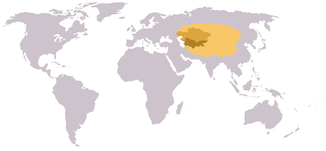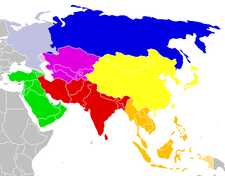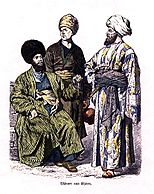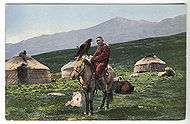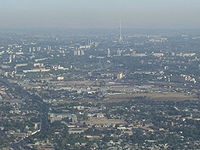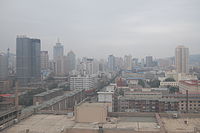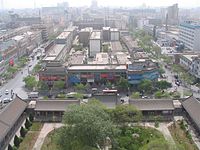- Central Asia
-
Central Asia 
Area 4,003,400 km2 (1,545,721 sq mi)[1] Population 61,551,945[2] Density 15 /km2 (39 /sq mi) Countries  Kazakhstan
Kazakhstan
 Kyrgyzstan
Kyrgyzstan
 Tajikistan
Tajikistan
 Turkmenistan
Turkmenistan
 Uzbekistan
UzbekistanNominal GDP (2009) $ 166 Billion GDP per capita (2009) $ 2,700 Central Asia is a core region of the Asian continent from the Caspian Sea in the west, China in the east, Afghanistan in the south, and Russia in the north. It is also sometimes referred to as Middle Asia, and, colloquially, "the 'stans" (as the five countries generally considered to be within the region all have names ending with that suffix)[3] and is within the scope of the wider Eurasian continent.
Various definitions of its exact composition exist, and no one definition is universally accepted. Despite this uncertainty in defining borders, it does have some important overall characteristics. For one, Central Asia has historically been closely tied to its nomadic peoples and the Silk Road.[4] As a result, it has acted as a crossroads for the movement of people, goods, and ideas between Europe, West Asia, South Asia, and East Asia.[5]
In modern contexts, all definitions of Central Asia include these five republics of the former Soviet Union: Kazakhstan (pop. 16.0 million), Kyrgyzstan (5.5 million), Tajikistan (7.3 million), Turkmenistan (5.1 million), and Uzbekistan (27.6 million), for a total population of 61.5 million as of 2009. Other areas often included are Mongolia, Afghanistan, Khyber Pakhtunkhwa, northeastern Iran, Kashmir, and sometimes Xinjiang and Tibet in western China and southern Siberia in Russia.
During pre-Islamic and early Islamic times, Central Asia was a predominantly Iranian[6][7] region that included sedentary Sogdians, Chorasmians, semi-nomadic Scythians and Alans. The ancient sedentary population played an important role in the history of Central Asia. After expansion by Turkic peoples, Central Asia also became the homeland for many Turkic peoples, including the Kazakhs, Uzbeks, Turkmen, Kyrgyz and Uyghurs. Central Asia is sometimes referred to as Turkestan.
Contents
Definitions
The idea of Central Asia as a distinct region of the world was introduced in 1843 by the geographer Alexander von Humboldt. The borders of Central Asia are subject to multiple definitions.
The most limited definition was the official one of the Soviet Union, which defined Middle Asia as consisting solely of Uzbekistan, Turkmenistan, Tajikistan and Kyrgyzstan. This definition was also often used outside the USSR during this period.
However, the Russian culture has two distinct terms: Средняя Азия (Srednjaja Azija or "Middle Asia", the narrower definition, which includes only those traditionally non-Slavic, Central Asian lands that were incorporated within those borders of historical Russia) and Центральная Азия (Central'naja Azija or "Central Asia", the wider definition, which includes Central Asian lands that have never been part of historical Russia).
Soon after independence, the leaders of the four former Soviet Central Asian Republics met in Tashkent and declared that the definition of Central Asia should include Kazakhstan as well as the original four included by the Soviets. Since then, this has become the most common definition of Central Asia.
The UNESCO general history of Central Asia, written just before the collapse of the USSR, defines the region based on climate and uses far larger borders. According to it, Central Asia includes Mongolia, Tibet, northeast Iran (Golestan, North Khorasan and Razavi provinces), Afghanistan, Northern Areas, N.W.F.P., Azad Kashmir and Punjab provinces of Pakistan, Punjab, Kashmir and Ladakh of India, central-east Russia south of the Taiga, and the former Central Asian Soviet republics (the five "Stans" of the former Soviet Union).
An alternative method is to define the region based on ethnicity, and in particular, areas populated by Eastern Turkic, Eastern Iranian, or Mongolian peoples. These areas include Xinjiang Uyghur Autonomous Region, the Turkic regions of southern Siberia, the five republics, and Afghan Turkestan. Afghanistan as a whole, the Northern Areas of Pakistan and the Kashmir Valley may also be included. The Tibetans and Ladakhi are also included. Insofar, most of the mentioned peoples are considered the "indigenous" peoples of the vast region.
There are several places that claim to be the geographic center of Asia, for example Kyzyl, the capital of Tuva in the Russian Federation, and a village 200 miles (320 km) north of Ürümqi, the capital of the Xinjiang region of China.[8]
Geography
Central Asia is an extremely large region of varied geography, including high passes and mountains (Tian Shan), vast deserts (Kara Kum, Kyzyl Kum, Taklamakan), and especially treeless, grassy steppes. The vast steppe areas of Central Asia are considered together with the steppes of Eastern Europe as a homogeneous geographical zone known as the Eurasian Steppe.
Much of the land of Central Asia is too dry or too rugged for farming. The Gobi desert extends from the foot of the Pamirs, 77° E, to the Great Khingan (Da Hinggan) Mountains, 116°–118° E.
Central Asia has the following geographic extremes:
- The world's northernmost desert (sand dunes), at Buurug Deliin Els, Mongolia, 50°18′ N.
- The Northern Hemisphere's southernmost permafrost, at Erdenetsogt sum, Mongolia, 46°17′ N.
- The world's shortest distance between non-frozen desert and permafrost: 770 km (480 mi).
- The Eurasian pole of inaccessibility.
A majority of the people earn a living by herding livestock. Industrial activity centers in the region's cities.
Major rivers of the region include the Amu Darya, the Syr Darya, the Hari River and the Murghab River. Major bodies of water include the Aral Sea and Lake Balkhash, both of which are part of the huge west-central Asian endorheic basin that also includes the Caspian Sea.
Both of these bodies of water have shrunk significantly in recent decades due to diversion of water from rivers that feed them for irrigation and industrial purposes. Water is an extremely valuable resource in arid Central Asia and can lead to rather significant international disputes.
Divisions
The northern belt is part of the Eurasian Steppe. In the northwest, north of the Caspian Sea, Central Asia merges into the Russian Steppe. To the northeast, Dzungaria and the Tarim Basin may sometimes be included in Central Asia. Just west of Dzungaria, Zhetysu, or Semirechye, is south of Lake Balkhash and north of the Tian Shan Mountains. Khorezm is south of the Aral Sea along the Amu Darya. Southeast of the Aral Sea, Maveranahr is between the Amu Darya and Syr Darya. Transoxiana is the land north of the middle and upper Amu Darya (Oxus). Bactria included northern Afghanistan and the upper Amu Darya. Sogdiana was north of Bactria and included the trading cities of Bukhara and Samarkhand. Khorasan and Margiana approximate northeastern Iran. The Kyzyl Kum Desert is northeast of the Amu Darya, and the Karakum Desert southwest of it.
Climate
Since Central Asia is not buffered by a large body of water, temperature fluctuations are more severe.
According to the WWF Ecozones system, Central Asia is part of the Palearctic ecozone. The largest biome in Central Asia is the temperate grasslands, savannas, and shrublands biome. Central Asia also contains the montane grasslands and shrublands, deserts and xeric shrublands and temperate coniferous forests biomes.
History
 Geographical extent of Iranian influence in the 1st century BC. Scythia (mostly Eastern Iranian) is shown in orange.
Geographical extent of Iranian influence in the 1st century BC. Scythia (mostly Eastern Iranian) is shown in orange.
The history of Central Asia is defined by the area's climate and geography. The aridness of the region made agriculture difficult, and its distance from the sea cut it off from much trade. Thus, few major cities developed in the region; instead, the area was for millennia dominated by the nomadic horse peoples of the steppe.
Relations between the steppe nomads and the settled people in and around Central Asia were long marked by conflict. The nomadic lifestyle was well suited to warfare, and the steppe horse riders became some of the most militarily potent peoples in the world, limited only by their lack of internal unity. Any internal unity that was achieved was most probably due to the influence of the Silk Road, which traveled along Central Asia. Periodically, great leaders or changing conditions would organize several tribes into one force and create an almost unstoppable power. These included the Hun invasion of Europe, the Wu Hu attacks on China and most notably the Mongol conquest of much of Eurasia.[9]
During pre-Islamic and early Islamic times, southern Central Asia was inhabited predominantly by speakers of Iranian languages.[6][10] Among the ancient sedentary Iranian peoples, the Sogdians and Chorasmians played an important role, while Iranian peoples such as Scythians and the later on Alans lived a nomadic or semi-nomadic lifestyle. The well-preserved Tarim mummies with Caucasoid features have been found in the Tarim Basin.[11]
The main migration of Turkic peoples occurred between the 5th and 10th centuries, when they spread across most of Central Asia. During the 13th and 14th centuries, the Mongols conquered and ruled the largest contiguous empire in recorded history.
The dominance of the nomads ended in the 16th century, as firearms allowed settled peoples to gain control of the region. Russia, China, and other powers expanded into the region and had captured the bulk of Central Asia by the end of the 19th century. After the Russian Revolution, the Central Asian regions were incorporated into the Soviet Union. Mongolia remained independent but became a Soviet satellite state. However, Afghanistan remained independent of any influence by the Russian empire.
The Soviet areas of Central Asia saw much industrialization and construction of infrastructure, but also the suppression of local cultures, hundreds of thousands of deaths from failed collectivization programs, and a lasting legacy of ethnic tensions and environmental problems. Soviet authorities deported millions of people, including entire nationalities,[12] from western areas of the USSR to Central Asia and Siberia.[13] According to Touraj Atabaki and Sanjyot Mehendale, "From 1959 to 1970, about two million people from various parts of the Soviet Union migrated to Central Asia, of which about one million moved to Kazakhstan."[14]
With the collapse of the Soviet Union, five countries gained independence. In nearly all the new states, former Communist Party officials retained power as local strongmen. None of the new republics could be considered functional democracies in the early days of independence, although it appears Kyrgyzstan, Kazakhstan and Mongolia have made great strides, unlike Uzbekistan, Tajikistan, and Turkmenistan.[citation needed]
Culture
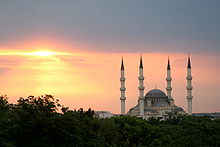 The Ärtogrul Gazy Mosque in Ashgabat named after the father of Osman Ghazi, the founder of the Ottoman Empire
The Ärtogrul Gazy Mosque in Ashgabat named after the father of Osman Ghazi, the founder of the Ottoman Empire
Religions
Islam is the religion most common in the Central Asian Republics, Afghanistan, Xinjiang and the peripheral western regions, such as Bashkiria. Most Central Asian Muslims are Sunni, although there are sizable Shia minorities in Afghanistan and Tajikistan.
Zoroastrianism, a religion with origins in Afghanistan, was a major faith in Central Asia prior to the arrival of Islam. It's influences is still felt today in such celebrations as Nowruz, held in all five of the "core" Central Asian states.
Buddhism was a prominent religion in Central Asia prior to the arrival of Islam, and the transmission of Buddhism along the Silk Road eventually brought the religion to China. Amongst the Turkic peoples, Tengrianism was the popular religion before arrival of Islam. Tibetan Buddhism is most common in Tibet, Mongolia, Ladakh and the southern Russian regions of Siberia, where Shamanism is also popular (including forms of divination, such as Kumalak). Contact and migration with Han people from China has brought Confucianism and other beliefs into the region.
Nestorianism was the form of Christianity most practiced in the region in previous centuries, but now the largest denomination is the Russian Orthodox Church, with many members in Kazakhstan. The Bukharan Jews were once a sizable community in Uzbekistan and Tajikistan, but nearly all have emigrated since the dissolution of the Soviet Union.
Arts
 Yama, the Lord of Death. Note the human skulls and severed heads that festoon Yama's crown and necklace, which give some concept of the size that Yama was expected to be when one faced him at one's death. This particular Dharmapala is painted wood, four feet high in total.
Yama, the Lord of Death. Note the human skulls and severed heads that festoon Yama's crown and necklace, which give some concept of the size that Yama was expected to be when one faced him at one's death. This particular Dharmapala is painted wood, four feet high in total.
At the crossroads of Asia, shamanistic practices live alongside Buddhism. Thus, Yama, Lord of Death, was revered in Tibet as a spiritual guardian and judge. Mongolian Buddhism, in particular, was influenced by Tibetan Buddhism. The Qianlong Emperor of China in the 18th century was Tibetan Buddhist and would sometimes travel from Beijing to other cities for personal religious worship.
Central Asia also has an indigenous form of improvisational oral poetry that is over 1000 years old. It is principally practiced in Kyrgyzstan and Kazakhstan by akyns, lyrical improvisationists. They engage in lyrical battles, the aitysh or the alym sabak. The tradition arose out of early bardic oral historians. They are usually accompanied by a stringed instrument—in Kyrgyzstan, a three-stringed komuz, and in Kazakhstan, a similar two-stringed instrument.
Photography in Central Asia began to develop after 1882, when a Russian Mennonite photographer named Wilhelm Penner moved to the Khanate of Khiva during the Mennonite migration to Central Asia led by Claas Epp, Jr.. Upon his arrival to Khanate of Khiva, Penner shared his photography skills with a local student Khudaybergen Divanov, who later became the founder of the Uzbek photography.[15]
Some also learn to sing the Manas, Kyrgyzstan's epic poem (those who learn the Manas exclusively but do not improvise are called manaschis). During Soviet rule, akyn performance was co-opted by the authorities and subsequently declined in popularity. With the fall of the Soviet Union, it has enjoyed a resurgence, although akyns still do use their art to campaign for political candidates. A 2005 Washington Post article proposed a similarity between the improvisational art of akyns and modern freestyle rap performed in the West.[16]
As a consequence of Russian colonization, European fine arts - painting, sculpture and graphics - have developed in Central Asia. The first years of the Soviet regime saw the appearance of modernism, which took inspiration from the Russian avant-garde movement. Until the 80's Central Asian arts had developed along with general tendencies of Soviet arts. In the 90's, arts of the region underwent some significant changes. Institutionally speaking, some fields of arts were regulated by the birth of the art market, some stayed as representatives of official views, while many were sponsored by international organizations. The years of 1990 - 2000 were times for the establishment of contemporary arts. In the region, many important international exhibitions are taking place, Central Asian art is represented in European and American museums, and the Central Asian Pavilion at the Venice Biennale has been organized since 2005.
Territory and region data
Country Area
km²Population
(2009)Population density
per km²Nominal GDP
millions of USD (2009)GDP per capita
(2009)Capital Official languages  Kazakhstan
Kazakhstan2,724,900 16,004,800 6 109,273 $6,823 Astana Kazakh, Russian  Kyrgyzstan
Kyrgyzstan199,900 5,482,000 27 4,570 $850 Bishkek Kyrgyz, Russian  Tajikistan
Tajikistan143,100 7,349,145 51 4,982 $766 Dushanbe Tajik (Persian)  Turkmenistan
Turkmenistan488,100 5,110,000 10 16,197 $3,242 Ashgabat Turkmen  Uzbekistan
Uzbekistan447,400 27,606,000 62 32,816 $1,175 Tashkent Uzbek Nations with territories sometimes included
Country or Territory Area
km²Population
(2009)Population density
per km²Capital Official languages  Afghanistan
Afghanistan647,500 31,889,923 49 Kabul Persian, Pashto  China
China9,640,821 1,338,612,968 139.6 Beijing Chinese  Iran
Iran1,648,195 76,923,300 45 Tehran Persian  Mongolia
Mongolia1,564,116 2,736,800 2 Ulan Bator Mongolian  Pakistan
Pakistan803,940 168,925,500 210 Islamabad Urdu, English  Russia
Russia13,000,000 141,945,966 8.3 Moscow Russian Demographics
By a broad definition including Mongolia and Afghanistan, but excluding Pakistan, more than 90 million people live in Central Asia, about 2% of Asia's total population. Of the regions of Asia, only North Asia has fewer people. It has a population density of 9 people per km², vastly less than the 80.5 people per km² of the continent as a whole.
Languages
Russian, as well as being spoken by around six million ethnic Russians and Ukrainians of Central Asia,[17] is the defacto lingua franca throughout the former Soviet Central Asian Republics. Mandarin Chinese has an equally dominant presence in Inner Mongolia, Qinghai and Xinjiang.
The languages of the majority of the inhabitants of the former Soviet Central Asian Republics come from the Turkic language group.[18] Turkmen, is mainly spoken in Turkmenistan, and as a minority language in Afghanistan, Iran and Turkey. Kazakh and Kyrgyz are related languages of the Kypchak group of Turkic languages and are spoken throughout Kazakhstan, Kyrgyzstan, and as a minority language in Tajikistan, Afghanistan and Xinjiang. Uzbek and Uyghur are spoken in Uzbekistan, Tajikistan, Afghanistan and Xinjiang.
The Turkic languages may belong to a larger, but controversial, Altaic language family, which includes Mongolian. Mongolian is spoken throughout Mongolia and into Buryatia, Kalmyk, Tuva, Inner Mongolia, and Xinjiang.
Iranian languages were once spoken throughout Central Asia, such as the once prominent Sogdian, Khwarezmian, Bactrian and Scythian languages are now extinct. The Eastern Iranian language of Pashto is still spoken in Afghanistan and northwestern Pakistan, and other minor East Iranian languages, such as Shughni, Munji, Ishkashimi, Sarikoli, Wakhi, Yaghnobi and Ossetian, are also spoken in various places in Central Asia. Varieties of Persian are also spoken as a major language in the region. Locally known as Darī (in Afghanistan), Tojikī (by Tajiks in Tajikistan), and Bukhori (by the Bukharan Jews all over Central Asia).
Other languages and language groups include the Tibetan language, spoken by around six million people across the Tibetan Plateau and into Qinghai, Sichuan and Ladakh. Dardic languages, such as Shina, Kashmiri and Khowar, are predominant in the northern areas of Pakistan, as well as in Ladakh of India and NWFP of Pakistan.
As a note, Tocharian, an Indo-European language, was once spoken in Xinjiang and parts of Afghanistan, but is now extinct.
Geostrategy
Central Asia has long been a strategic location merely because of its proximity to several great powers on the Eurasian landmass. The region itself never held a dominant stationary population nor was able to make use of natural resources. Thus, it has rarely throughout history become the seat of power for an empire or influential state. Central Asia has been divided, redivided, conquered out of existence, and fragmented time and time again. Central Asia has served more as the battleground for outside powers than as a power in its own right.
Central Asia had both the advantage and disadvantage of a central location between four historical seats of power. From its central location, it has access to trade routes to and from all the regional powers. On the other hand, it has been continuously vulnerable to attack from all sides throughout its history, resulting in political fragmentation or outright power vacuum, as it is successively dominated.
 Political cartoon from the period of the Great Game showing the Afghan Amir Sher Ali with his "friends" Imperial Russia and the United Kingdom (1878)
Political cartoon from the period of the Great Game showing the Afghan Amir Sher Ali with his "friends" Imperial Russia and the United Kingdom (1878)
- To the North, the steppe allowed for rapid mobility, first for nomadic horseback warriors like the Huns and Mongols, and later for Russian traders, eventually supported by railroads. As the Russian Empire expanded to the East, it would also push down into Central Asia towards the sea, in a search for warm water ports. The Soviet bloc would reinforce dominance from the North and attempt to project power as far south as Afghanistan.
- To the East, the demographic and cultural weight of Chinese empires continually pushed outward into Central Asia. The Manchu Qing dynasty would conquer Xinjiang and Tibet. However, with the Sino-Soviet split, China would project power into Central Asia, most notably in the case of Afghanistan, to counter Russian dominance of the region.
- To the Southeast, the demographic and cultural influence of India was felt in Central Asia, notably in Tibet, the Hindu Kush, and slightly beyond. Several historical Indian dynasties, especially those seated along the Indus River, would expand into Central Asia. India's ability to project power into Central Asia has been limited due to the mountain ranges in Pakistan, as well as the cultural differences between Hindu India and what would become a mostly Muslim Central Asia. From its base in India, the British Empire competed with the Russian Empire for influence in the region in the 19th and 20th centuries.
- To the Southwest, Western Asian powers have expanded into the southern areas of Central Asia (usually Uzbekistan, Afghanistan, and Pakistan). Several Persian empires would conquer and reconquer parts of Central Asia; Alexander the Great's Hellenic empire would extend into Central Asia; two Islamic empires would exert substantial influence throughout the region; and the modern state of Iran has projected influence throughout the region as well.
In the post–Cold War era, Central Asia is an ethnic cauldron, prone to instability and conflicts, without a sense of national identity, but rather a mess of historical cultural influences, tribal and clan loyalties, and religious fervor. Projecting influence into the area is no longer just Russia, but also Turkey, Iran, China, Pakistan, India and the United States:
- Russia continues to dominate political decision-making throughout the former SSRs; although, as other countries move into the area, Russia's influence has begun to wane.
- The United States, with its military involvement in the region and oil diplomacy, is also significantly involved in the region's politics. The United States and other NATO members are the main contributors to the International Security Assistance Force in Afghanistan and also exert considerable influence in other Central Asian nations.
- China has security ties with Central Asian states through the Shanghai Cooperation Organization, and conducts energy trade bilaterally.[19]
- India has geographic proximity to the Central Asian region and, in addition, enjoys considerable influence on Afghanistan.[20][21] India maintains a military base at Farkhor, Tajikistan, and also has extensive military relations with Kazakhstan and Uzbekistan.[22]
- Turkey also exerts considerable influence in the region on account of its ethnic and linguistic ties with the Turkic peoples of Central Asia and its involvement in the Baku-Tbilisi-Ceyhan oil pipeline. Political and economic relations are growing rapidly (e.g., Turkey recently eliminated visa requirements for citizens of the Central Asian Turkic republics).
- Iran, the seat of historical empires that controlled parts of Central Asia, has historical and cultural links to the region and is vying to construct an oil pipeline from the Caspian Sea to the Persian Gulf.
- Pakistan, a nuclear-armed Islamic state, has a history of political relations with neighboring Afghanistan and is termed capable of exercising influence. For some Central Asian nations, the shortest route to the ocean lies through Pakistan. Pakistan seeks natural gas from Central Asia and supports the development of pipelines from its countries. The mountain ranges and areas in northern Pakistan lie on the fringes of greater Central Asia; the Gilgit-Baltistan region of Pakistan lies adjacent to Tajikistan, separated only by the narrow Afghan Wakhan Corridor. Being located on the northwest of South Asia, the area forming modern-day Pakistan maintained extensive historical and cultural links with the region.
War on Terror
In the context of the United States' War on Terror, Central Asia has once again become the center of geostrategic calculations. Pakistan's status has been upgraded by the U.S. government to Major non-NATO ally because of its central role in serving as a staging point for the invasion of Afghanistan, providing intelligence on Al-Qaeda operations in the region, and leading the hunt on Osama bin Laden.
Afghanistan, which had served as a haven and source of support for Al-Qaeda under the protection of Mullah Omar and the Taliban, was the target of a U.S. invasion in 2001 and ongoing reconstruction and drug-eradication efforts. U.S. military bases have also been established in Uzbekistan and Kyrgyzstan, causing both Russia and the People's Republic of China to voice their concern over a permanent U.S. military presence in the region.
Western governments have accused Russia, China and the former Soviet republics of justifying the suppression of separatist movements, and the associated ethnics and religion with the War on Terror.
Major cultural and economic centres
Cities within the possible boundaries of Central Asia
City Country Population Image Information Astana  Kazakhstan
Kazakhstan708,794
(2010)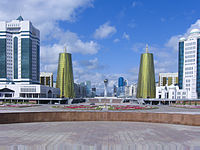
The capital and second largest city in Kazakhstan. After Kazakhstan gained its independence in 1991, the city and the region were renamed Aqmola. The name was often translated as "White Tombstone", but actually means "Holy Place" or "Holy Shrine". The "White Tombstone" literal translation was too appropriate for many visitors to escape notice in almost all guide books and travel accounts. In 1994, the city was designated as the future capital of the newly independent country and again renamed to the present Astana after the capital was officially moved from Almaty in 1997. Almaty  Kazakhstan
Kazakhstan1,421,868
(2010)
It was the capital of Kazakhstan (and its predecessor, the Kazakh SSR) from 1929 to 1998. Despite losing its status as the capital, Almaty remains the major commercial center of Kazakhstan. It is a recognised financial centre of Kazakhstan and the Central Asian region. Bishkek  Kyrgyzstan
Kyrgyzstan865,527
(2009)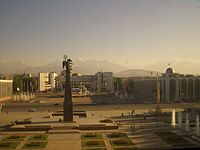
The capital and the largest city of Kyrgyzstan. Bishkek is also the administrative center of Chuy Province, which surrounds the city, even though the city itself is not part of the province, but rather a province-level unit of Kyrgyzstan. Osh  Kyrgyzstan
Kyrgyzstan243,216
(2009)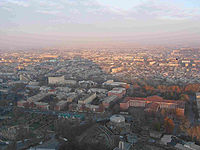
The second largest city of Kyrgyzstan. Osh is also the administrative center of Osh Province, which surrounds the city, even though the city itself is not part of the province, but rather a province-level unit of Kyrgyzstan. Dushanbe  Tajikistan
Tajikistan679,400
(2008)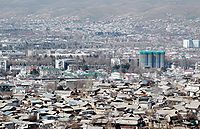
The capital and largest city of Tajikistan. Dushanbe means "Monday" in Tajik and Persian,[23] and the name reflects the fact that the city grew on the site of a village that originally was a popular Monday marketplace. Ashgabat  Turkmenistan
Turkmenistan909,000
(2009)
The capital and largest city of Turkmenistan. Ashgabat is a relatively young city, growing out of a village of the same name established by Russians in 1818. It is not far from the site of Nisa, the ancient capital of the Parthians, and it grew on the ruins of the Silk Road city of Konjikala, which was first mentioned as a wine-producing village in the 2nd century BCE and was leveled by an earthquake in the 1st century BCE (a precursor of the 1948 Ashgabat earthquake). Konjikala was rebuilt because of its advantageous location on the Silk Road, and it flourished until its destruction by Mongols in the 13th century CE. After that, it survived as a small village until the Russians took over in the 19th century.[24][25] Bukhara  Uzbekistan
Uzbekistan237,900
(1999)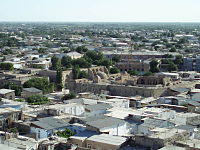
The nation's fifth-largest city and the capital of the Bukhara Province of Uzbekistan. Bukhara has been one of the main centres of Persian civilization from its early days in the 6th century BCE, and, since 12th century CE, Turkic speakers gradually moved in. Its architecture and archaeological sites form one of the pillars of Central Asian history and art. Samarkand  Uzbekistan
Uzbekistan596,300
(2008)
The second largest city in Uzbekistan and the capital of Samarqand Province. The city is most noted for its central position on the Silk Road between China and the West, and for being an Islamic centre for scholarly study. Tashkent  Uzbekistan
Uzbekistan2,180,000
(2008)The capital and largest city of Uzbekistan. In pre-Islamic and early Islamic times, the town and the province were known as Chach. Tashkent started as an oasis on the Chirchik River, near the foothills of the Golestan Mountains. In ancient times, this area contained Beitian, probably the summer "capital" of the Kangju confederacy.[26] Kabul  Afghanistan
Afghanistan3,895,000
(2011)
The capital and largest city of Afghanistan. The city of Kabul is thought to have been established between 2000 BCE and 1500 BCE.[27] In the Rig Veda (composed between 1700–1100 BCE), the word Kubhā is mentioned, which appears to refer to the Kabul River.[28] Mazar-e Sharif  Afghanistan
Afghanistan375,181
(2008)
The fourth largest city in Afghanistan and capital of Balkh province is linked by roads to Kabul in the southeast, Herat to the west and Uzbekistan to the north. Hohhot  China
China2,866,615
(2010)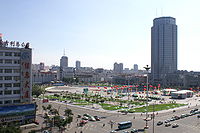
The capital and largest city in Inner Mongolia Autonomous Region and the cultural center of the Mongols in China. Lanzhou  China
China3,616,163
(2010)The capital and largest city in Gansu Province and one of the economic center of western China. Two thousand years ago, Lanzhou was an important town on the Silk Road, a vast network of trade routes that also facilitated cultural exchanges throughout Eurasia. Ürümqi  China
China3,110,280
(2010)
The capital and largest city in Xinjiang Uyghur Autonomous Region and the cultural center of the Uyghurs. Two thousand years ago, Ürümqi was an important town on the northern route of the Silk Road, a vast network of trade routes that also facilitated cultural exchanges throughout Eurasia. Yinchuan  China
China1,993,088
(2010)The capital and largest city in Ningxia Hui Autonomous Region and the cultural center of the Hui in China. Mashhad  Iran
Iran2,907,316
(2006)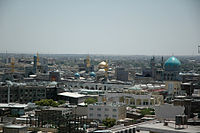
The second largest city in Iran and one of the holiest cities in the Shia world. At the beginning of the 9th century (3rd century AH), Mashhad was a small village called Sanabad situated 24 km away from Tus. It was not considered a great city until Mongol raids in 1220 caused the destruction of many large cities in the Greater Khorasan territories, leaving Mashhad relatively intact. Thus, the survivors of the massacres migrated to Mashhad.[29] Nishapur  Iran
Iran270,972
(2006)
The city is located in the Razavi Khorasan province in northeastern Iran, situated in a fertile plain at the foot of the Binalud Mountains, near the regional capital of Mashhad. It is the hometown of several respected Persian poets and artists, including Omar Khayyám, Attar Neyshapuri and Kamal-ol-molk. Tus  Iran
IranN/A 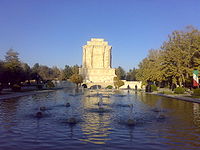
An ancient city in the Iranian province of Razavi Khorasan. To the ancient Greeks, it was known as Susia (Gr. Σούσια). It was captured by Alexander the Great in 330 BC. The city was almost entirely destroyed by Genghis Khan's Mongol conquest in 1220. Ulaanbaatar  Mongolia
Mongolia1,172,400
(2011)
The capital and largest city in Mongolia and the cultural center of the Mongolians. The city was founded in 1639 as an initially nomadic Buddhist monastic centre. Since 1778, it has been located in the Tuul River valley. In the 20th century, Ulaanbaatar grew into a major manufacturing centre. Peshawar  Pakistan
Pakistan3,625,000
(2010)
Peshawar is the capital of the Khyber Pakhtunkhwa province of Pakistan, located on the edge of the Khyber Pass near the Afghan border. In ancient times, a major settlement called Purushpur (Sanskrit for "city of men") was established by Kanishka, the Kushan king, in the general area of modern Peshawar. Purushpur emerged as a major center of Buddhist learning, and the capital of the ancient Gandhara was moved to Peshawar in the 2nd century CE. During much of its history, Peshawar was one of the main trading centres on the ancient Silk Road and was a major crossroads for various cultures between Central Asia, South Asia and the Middle East. Novosibirsk  Russia
Russia1,473,700
(2010)
Novosibirsk is the capital of Novosibirsk Oblast, located on the edge of Siberia near the Kazakhstan border. Novosibirsk is the largest city in Siberia and third largest city in Russia. Omsk  Russia
Russia1,154,000
(2010)
Omsk is the capital of Omsk Oblast, located on the edge of Siberia near the Kazakhstan border.Omsk is the second largest city in east of the Ural Mountains in Russia. See also
- Cambridge Central Asia Forum
- Central Asian studies
- Central Asian Union
- Continental pole of inaccessibility
- Economic Cooperation Organization
- Hindutash
- University of Central Asia
- Central Asians in Ancient Indian literature
References
- ^ The area figure is based on the combined areas of five countries in Central Asia.
- ^ The population figure is the combined populations of 5 countries in Central Asia (last updated Feb 22, 2010).
- ^ Paul McFedries (2001-10-25). "stans". Word Spy. http://www.wordspy.com/words/stans.asp. Retrieved 2011-02-16.
- ^ Steppe Nomads and Central Asia
- ^ Travelers on the Silk Road
- ^ a b Encyclopædia Iranica, "CENTRAL ASIA: The Islamic period up to the Mongols", C. Edmund Bosworth: "In early Islamic times Persians tended to identify all the lands to the northeast of Khorasan and lying beyond the Oxus with the region of Turan, which in the Shahnama of Ferdowsi is regarded as the land allotted to Fereydun's son Tur. The denizens of Turan were held to include the Turks, in the first four centuries of Islam essentially those nomadizing beyond the Jaxartes, and behind them the Chinese (see Kowalski; Minorsky, "Turan"). Turan thus became both an ethnic and a diareeah term, but always containing ambiguities and contradictions, arising from the fact that all through Islamic times the lands immediately beyond the Oxus and along its lower reaches were the homes not of Turks but of Iranian peoples, such as the Sogdians and Khwarezmians."
- ^ C.E. Bosworth, "The Appearance of the Arabs in Central Asia under the Umayyads and the establishment of Islam", in History of Civilizations of Central Asia, Vol. IV: The Age of Achievement: AD 750 to the End of the Fifteenth Century, Part One: The Historical, Social and Economic Setting, edited by M. S. Asimov and C. E. Bosworth. Multiple History Series. Paris: Motilal Banarsidass Publ./UNESCO Publishing, 1999. excerpt from page 23: "Central Asia in the early seventh century, was ethnically, still largely an Iranian land whose people used various Middle Iranian languages.". [1]
- ^ 43°40'52"N 87°19'52"E Degree Confluence Project.
- ^ A Land Conquered by the Mongols
- ^ C.E. Bosworth, "The Appearance of the Arabs in Central Asia under the Umayyads and the establishment of Islam", in History of Civilizations of Central Asia, Vol. IV: The Age of Achievement: AD 750 to the End of the Fifteenth Century, Part One: The Historical, Social and Economic Setting, edited by M. S. Asimov and C. E. Bosworth. Multiple History Series. Paris: UNESCO Publishing, 1998. excerpt from page 23: "Central Asia in the early seventh century, was ethnically, still largely an Iranian land whose people used various Middle Iranian languages.
- ^ Saiget, Robert J. (19 April 2005). "Caucasians preceded East Asians in basin". The Washington Times (News World Communications). Archived from the original on 20 April 2005. http://web.archive.org/web/20050420224622/http://washingtontimes.com/world/20050419-101056-2135r.htm. Retrieved 20 August 2007. "A study last year by Jilin University also found that the mummies' DNA had Europoid genes."
- ^ Deported Nationalities
- ^ Anne Applebaum – Gulag: A History Intro
- ^ "Central Asia and the Caucasus: transnationalism and diaspora". Touraj Atabaki, Sanjyot Mehendale (2005). p.66. ISBN 0-415-33260-5
- ^ Walter Ratliff, "Pilgrims on the Silk Road: A Muslim-Christian Encounter in Khiva", Wipf and Stock Publishers, 2010
- ^ «In Central Asia, a Revival of an Ancient Form of Rap - Art of Ad-Libbing Oral History Draws New Devotees in Post-Communist Era» by Peter Finn, Washington Post Foreign Service, Sunday, March 6, 2005, p. A20.
- ^ Robert Greenall, Russians left behind in Central Asia, BBC News, 23 November 2005.
- ^ Ethnographic maps
- ^ Scheineson, Andrew (2009-03-24). "The Shanghai Cooperation Organization". Backgrounder. Council on Foreign Relations. http://www.cfr.org/publication/10883/shanghai_cooperation_organization.html. Retrieved 2010-09-24.
- ^ India: Afghanistan's influential ally
- ^ India, Pakistan and the Battle for Afghanista
- ^ Reiter, Erich. The Impact of Asian Powers on Global Developments. Springer, 2004. ISBN 3790800929, 9783790800920.
- ^ D. Saimaddinov, S. D. Kholmatova, and S. Karimov, Tajik-Russian Dictionary, Academy of Sciences of the Republic of Tajikistan, Rudaki Institute of Language and Literature, Scientific Center for Persian-Tajik Culture, Dushanbe, 2006.
- ^ Konjikala: the Silk Road precursor of Ashgabat
- ^ Konjikala, in: MaryLee Knowlton, Turkmenistan, Marshall Cavendish, 2006, pp. 40-41, ISBN 0-7614-2014-2, ISBN 978-0-7614-2014-9 (viewable on Google Books).
- ^ Pulleyblank, Edwin G. 1963. "The consonantal system of Old Chinese." Asia Major 9 (1963), p. 94.
- ^ The history of Afghanistan, Ghandara.com website
- ^ "Kabul" Chambers's Encyclopaedia: A Dictionary of Universal Knowledge (1901 edition) J.B. Lippincott Company, NY, page 385
- ^ Zabeth (1999) pp. 14-15
Further reading
- Chow, Edward. "Central Asia's Pipelines: Field of Dreams and Reality", in Pipeline Politics in Asia: The Intersection of Demand, Energy Markets, and Supply Routes. National Bureau of Asian Research, 2010.
- Dani, A.H. and V.M. Masson, eds. UNESCO History of Civilizations of Central Asia. Paris: UNESCO, 1992.
- Gorshunova . Olga V. Svjashennye derevja Khodzhi Barora…, ( Sacred Trees of Khodzhi Baror: Phytolatry and the Cult of Female Deity in Central Asia) in Etnoragraficheskoe Obozrenie, 2008, n° 1, pp. 71–82. ISSN 0869-5415. (Russian).
- Mandelbaum, Michael, ed. Central Asia and the World: Kazakhstan, Uzbekistan, Tajikistan, Kyrgyzstan, and Turkmenistan. New York: Council on Foreign Relations Press, 1994.
- Marcinkowski, M. Ismail. Persian Historiography and Geography: Bertold Spuler on Major Works Produced in Iran, the Caucasus, Central Asia, Pakistan and Early Ottoman Turkey. Singapore: Pustaka Nasional, 2003.
- Olcott, Martha Brill. Central Asia's New States: Independence, Foreign policy, and Regional security. Washington, D.C.: United States Institute of Peace Press, 1996.
- Soucek, Svatopluk. A History of Inner Asia. Cambridge: Cambridge University Press, 2000.
- Rall, Ted. Silk Road to Ruin: Is Central Asia the New Middle East? New York: NBM Publishing, 2006.
- Stone, L.A. The International Politics of Central Eurasia (272 pp). Central Eurasian Studies On Line: Accessible via the Web Page of the International Eurasian Institute for Economic and Political Research: http://www.iicas.org/forumen.htm
- Weston, David. Teaching about Inner Asia, Bloomington, Indiana: ERIC Clearinghouse for Social Studies, 1989.
External links
- The Library: Central on politics, universities, culture, languages, etc.
- The famous symphonic picture "In the Steppes of Central Asia" of Alexander Borodin in Film "Moscow clad in snow", 00:07:22, 1908 on YouTube
- Central Asian Gateway Project of UNDP and CER, managed by N. Talibdjanov (since 2003).
- Modernity, State and Society in Central Asia: A Research Guide
Countries and territories of Central Asia
Sometimes included: Kazakhstan ·
Kazakhstan ·  Kyrgyzstan ·
Kyrgyzstan ·  Tajikistan ·
Tajikistan ·  Turkmenistan ·
Turkmenistan ·  Uzbekistan
Uzbekistan Afghanistan ·
Afghanistan ·  China (Xinjiang Province) ·
China (Xinjiang Province) ·  Iran (Khorasan Province) ·
Iran (Khorasan Province) ·  Mongolia ·
Mongolia ·  Pakistan (Khyber Pakhtunkhwa, Gilgit Baltistan) ·
Pakistan (Khyber Pakhtunkhwa, Gilgit Baltistan) ·  Russia (Siberia, Tatarstan)
Russia (Siberia, Tatarstan)Regions of the world 
Africa Northern · Sub-Saharan (Central · Southern · Western · Eastern) 
Oceania Australasia (Australia) · Melanesia · Micronesia · Polynesia 
America North (Northern • Middle • Central • Caribbean) · South (Southern • Northern • Western) · Anglo · Latin 
Polar Arctic · Antarctic 
Asia Central · Eastern (Northeastern) · Northern · Southeastern · Southern (Indian subcontinent) · Western (Middle East) 
Oceans World · Arctic · Atlantic · Indian · Pacific · Southern 
Europe Central · Eastern · Northern · Southeastern · Southern · Western 
Seas List of seas Related Continents of the world · List of seas · Physical EarthCategories:- Central Asia
- Regions of Asia
- Biodiversity hotspots
Wikimedia Foundation. 2010.


